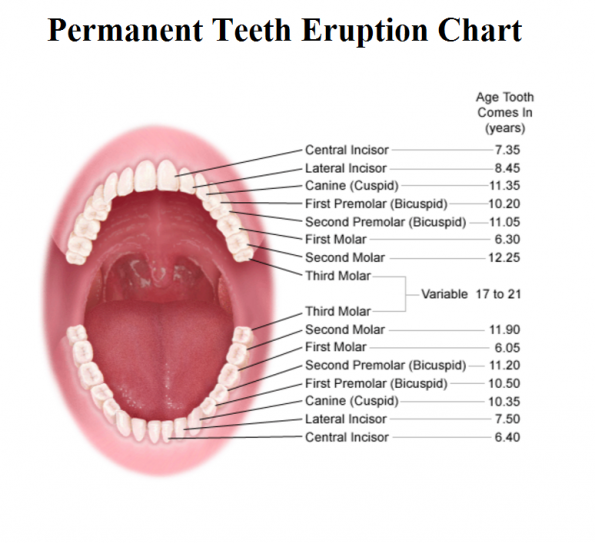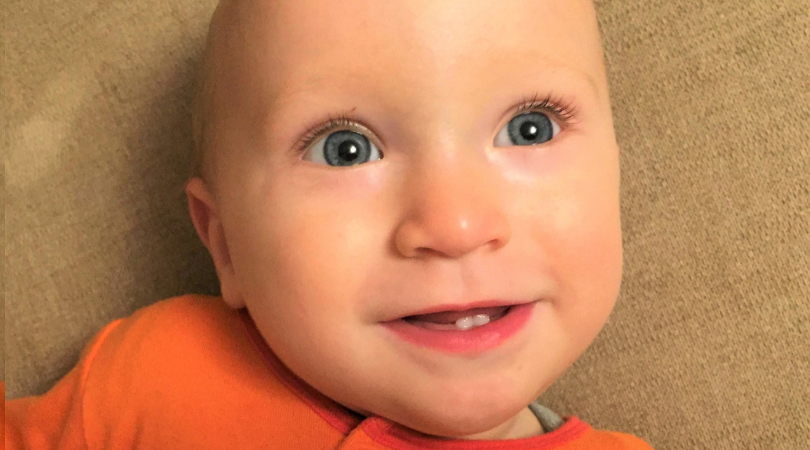
Coping When Your Six Year Old Starts Teething (again!)

*Affiliate links
Whenever we talk about teething it’s usually in relation to baby teething but why do we overlook when our children start to get their big teeth? You may think it was all over once those dreaded molars came through at around 2 1/2 but nope, those big teeth are just laying in wait for their big eruption day! And here we go again. You suddenly have a teething six year old and even though it may not be as traumatic as baby teething, it certainly can mix things up for you all…
What’s First?
So just like baby teething, the big teeth come through in a certain order and the very first to break through are in fact the adult molars. These don’t have baby versions and pop up in the gap at the back. Babies have 20 teeth but a fully grown adult has 32 which is why there are extra gaps and spaces for these to take their places.

A rough guide of the order the teeth will erupt
When these molars begin to cut the first signs for your child may be them noticing some sharp edges with their tongue or pain as the teeth start to cut through the gum. The gum back here is quite thick so your child may notice changes over a number of weeks as the large molars push fully through. This can result in symptoms which include pain, aching, earache, soreness and so on. Just like in baby teething, these teeth can cause a variety of symptoms which can come and go. The biggest difference now is that your child can tell you exactly where it hurts, how it feels and what they need. Hooray!
The Next Stage
The next stage you will see is your child shedding their baby teeth. This tends to follow the same pattern as the order they erupted in and most children will lose their bottom incisors first. This is usually pretty painless, with the new transition being quite exciting for them. You will notice the tooth becoming more wobbly, it will probably change position, it may look wonky at times and should naturally come away from the gum as the adult tooth pushes its way up. The baby teeth have no roots meaning they won’t have anything holding them in and any accidental knock to the mouth resulting in the tooth falling out shouldn’t cause them any damage (keep an eye on any bleeding, changes or infection though).
The Adult Teeth
As the baby teeth fall out you may immediately see the peak of the new adult tooth… or you may not! Yep, each tooth may be very different to the last and whereas some may be completely ready to pop through, others may take their time. It’s just the way the body works sometimes. If a tooth has been knocked out, the adult tooth below won’t be quite ready to come up yet, but a baby tooth that has held on and on for dear life will probably have an adult tooth below dying to break out!
Differences Between Children
Over the course of losing teeth and gaining new teeth, you may notice that each child at school will be at different stages. Some may have lots of gaps where the baby teeth have gone and the adult teeth are yet to break through, some may have a mouthful of new adult teeth already and others may be far slower at losing these first teeth. As with all development, each child varies and it isn’t anything to worry about. After all, some babies are born with teeth whereas others don’t get their first tooth until a year old. If your child was an early teether, they are more than likely going to lose these baby teeth earlier than a later teether. All that matters is that those baby teeth fall out before the adult ones erupt, that everything begins to align and no extra teeth are cropping up. Adult teething takes place from around the ages of 6-12 years so this is a long process. If you are concerned about any of this new teething process always seek advice from your dentist.

You May Also Like:
How to Prepare your Child for their First Dentist’s Appointment
Dealing With Teething Symptoms
You can deal with teething symptoms and pain in practically the same way as you did the first time around (bar the teething toys I’m sure!!)
Pain
Any pain and discomfort can be treated using infant paracetamol or infant ibuprofen (always follow the instructions and dosage rates). You can also provide this if the pain is showing in other areas, such as the ear, face, cheek, head and so on.
Teething gels can be applied to the gum to provide some light relief to the pain or rubbing caused by the new teeth erupting.
Amber jewellery can help to tackle teething issues in the same way as it does in baby teething.
Cooling Relief
Sometimes the pain is more of a discomfort than an intense pain so some cooling of the mouth and gums is all that is required. A cold flannel, cold water, cucumber sticks and ice cubes are all perfect for soothing swollen gums. I don’t recommend these for your baby but for a 6+ year old they will be fine.
Calming
Pain can often result in distress especially for children who haven’t learnt how to deal with it. It can be very upsetting for them to experience pain and not being able to make it go away. Plus children rarely stay still which means they don’t rest to feel better. The best remedies for calming are weak camomile tea, teething granules, amber jewellery, giving regular pain relief and listening to their needs at the time. Let them tell you how you can help them. Sometimes just some snuggles are the best remedy!
Distraction
The distraction technique is probably one of my favourite teething remedies as it can truly work wonders. It can be harder in babies as they aren’t as active but for a child getting their adult teeth, you can easily find activities that will completely distract them from any teething pain. Games, computers, art, going for walks/getting outside, visiting a park, watching films, the list can go on and on.
Eating
One of the trickiest parts of losing and gaining new teeth is eating. With new gaps, sore gums and new teeth to get used to, you may find that your child struggles with some textures. The best way to overcome this is to allow them to work out where they CAN bite, where they CAN chew and encourage them to try their best with meals. When the front teeth fall out you will probably see your child biting on the side of their mouth, using their pre-molars or canines rather than their incisors. With the eruption of the big molars, they may find grinding their food very uncomfortable so offering softer foods during this time would be beneficial. It may not always look nice to see them eat but by allowing them to do what they need to do will prevent them from developing food aversions or worries.
Dental Care
Looking after those brand new adult teeth is extremely important. These are the teeth that need to last them a lifetime. Hopefully, by this age, you will have a good brushing routine with them but if you are struggling why not use my teeth brushing chart to help to encourage them?
Top tips for brushing are:
- Follow the 2 minute rule. Use music, a timer or apps to help with this.
- Use a good age-appropriate toothbrush. If the bristles are flattened you will need to replace this.
- Check you are using the correct toothpaste for their age. There are a number of varieties on the market and from the age of 6 these usually go up another stage.
- Use a toothpaste that contains fluoride.
- Brush twice a day. Every day.
- Brush together if it helps.
- Visit a dentist at least twice a year who can advise on how your child is brushing.
As with baby teeth, the usual guidelines apply when it comes to sugar intake. Limit their sugary snacks, offer fruit instead, avoid sugary drinks and opt for water where possible, don’t allow them to go to bed with a sugary drink, don’t eat or drink (other than water) after brushing their teeth at night, avoid sweets as much as possible.
The NHS website states:
‘It is estimated that around one in three adults in England have tooth decay and a survey of five year old children carried out in 2012 found that more than one in four had some degree of tooth decay.’

One thing you may now need to start to do is encouraging them to floss their teeth. The baby teeth have large gaps between them which allows food and drink to move through easily. The adult teeth sit tightly together which can trap more food and bacteria which brushing alone may not always reach. Showing your child how to care for these new teeth from the start, will encourage them to keep this up throughout their lives.
Overall, adult teething should be far easier and less disruptive than with baby teething and, as with all aspects of teething, if you have any concerns whatsoever, always visit your dentist.

If you have a teething baby and want to find out more about this process you can purchase my book Your Teething Baby, from one parent to another here.
*This post contains ad links including Affiliate links.
Pin for later:





